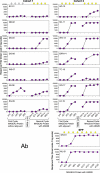Booster vaccination of cancer patients with MAGE-A3 protein reveals long-term immunological memory or tolerance depending on priming
- PMID: 18216244
- PMCID: PMC2234199
- DOI: 10.1073/pnas.0707140104
Booster vaccination of cancer patients with MAGE-A3 protein reveals long-term immunological memory or tolerance depending on priming
Abstract
We previously reported results of a phase II trial in which recombinant MAGE-A3 protein was administered with or without adjuvant AS02B to 18 non-small-cell lung cancer (NSCLC) patients after tumor resection. We found that the presence of adjuvant was essential for the development of humoral and cellular responses against selected MAGE-A3 epitopes. In our current study, 14 patients that still had no evidence of disease up to 3 years after vaccination with MAGE-A3 protein with or without adjuvant received an additional four doses of MAGE-A3 protein with adjuvant AS02B. After just one boost injection, six of seven patients originally vaccinated with MAGE-A3 protein plus adjuvant reached again their peak antibody titers against MAGE-A3 attained during the first vaccination. All seven patients subsequently developed even stronger antibody responses. Furthermore, booster vaccination widened the spectrum of CD4(+) and CD8(+) T cells against various new and known MAGE-A3 epitopes. In contrast, only two of seven patients originally vaccinated with MAGE-A3 protein alone developed high-titer antibodies to MAGE-A3, and all these patients showed very limited CD4(+) and no CD8(+) T cell reactivity, despite now receiving antigen in the presence of adjuvant. Our results underscore the importance of appropriate antigen priming using an adjuvant for generating persistent B and T cell memory and allowing typical booster responses with reimmunization. In contrast, absence of adjuvant at priming compromises further immunization attempts. These data provide an immunological rationale for vaccine design in light of recently reported favorable clinical responses in NSCLC patients after vaccination with MAGE-A3 protein plus adjuvant AS02B.
Conflict of interest statement
Conflict of interest statement: GlaxoSmithKline has licensed from the Ludwig Institute for Cancer Research certain patents relating to the compositions used in the clinical trial reported in this article. E.R., G.R., E.W.H., L.J.O., and S.G. are employees of the Ludwig Institute for Cancer Research; however, none of them are inventors of the relevant patents.
Figures




References
-
- Simpson AJ, Caballero OL, Jungbluth A, Chen YT, Old LJ. Nat Rev Cancer. 2005;5:615–625. - PubMed
-
- Gure AO, Chua R, Williamson B, Gonen M, Ferrera CA, Gnjatic S, Ritter G, Simpson AJ, Chen YT, Old LJ, et al. Clin Cancer Res. 2005;11:8055–8062. - PubMed
-
- Weynants P, Lethe B, Brasseur F, Marchand M, Boon T. Int J Cancer. 1994;56:826–829. - PubMed
-
- Toes RE, van der Voort EI, Schoenberger SP, Drijfhout JW, van Bloois L, Storm G, Kast WM, Offringa R, Melief CJ. J Immunol. 1998;160:4449–4456. - PubMed
-
- Gnjatic S, Atanackovic D, Matsuo M, Jäger E, Lee S-Y, Valmori D, Chen YT, Ritter G, Knuth A, Old LJ. J Immunol. 2003;170:1191–1196. - PubMed
Publication types
MeSH terms
Substances
LinkOut - more resources
Full Text Sources
Other Literature Sources
Medical
Research Materials

